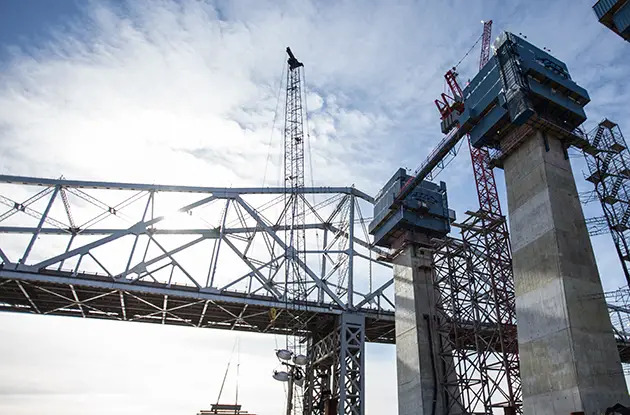As the area’s first new bridge in more than 50 years arises across the Hudson River, local educators are seizing the opportunity to spark students’ interest in STEM learning.
“He learned a lot about the materials used, and about the crane,” Hirsch said, referring to the super crane, dubbed I Lift NY, which arrived in Piermont in October 2014. With a lifting capacity of 1,900 tons and a boom length of 328 feet, it is one of the world’s largest floating cranes. “He told me it waited for low tide so it could go under the [current] bridge.”
As anyone who crosses the Tappan Zee these days can see, the new bridge is rising steadily and very visibly, no doubt sparking its share of family conversations about what is taking place across the river. And so, too, in classrooms, library programs, Boy Scout and Girl Scout meetings, and elsewhere. The assembly at Upper Nyack Elementary is just one of many ways in which bridge officials and area teachers are using the New York area’s first major bridge project since the Verrazano-Narrows Bridge opened in 1964 as an educational tool.
With other massive, lengthy public-works projects currently in various stages of progress or planning throughout the region—bridges in Staten Island, a new Penn Station, a transit tunnel to New Jersey, and more—these educational efforts can serve as an example for other teachers looking to capitalize on real-world happenings to spur kids’ interest in topics such as engineering and environmentalism.
RELATED: Find STEM After-School Activities Near You
Bridge Construction: A Five-Year Plan
Referred to for now as the New NY Bridge project, the still-unnamed $4 billion twin-span, cable-stayed bridge is slated to open in 2 years with eight traffic lanes, four eastbound and four westbound, plus emergency and breakdown lanes, a traffic-monitoring system, and bicycle and walking path with six viewing areas. It has space and structure to accommodate rail when funds become available.
By October of 2013, pile installation for the new bridge had started, and would lay the necessary groundwork for 43 approach span piers, each formed by groups of piles—and paving the way for something else as well. That summer, too, educators boarded a tugboat in the Hudson River to learn about the project up close. Their extensive talks resulted in a creative five-year educational plan that coincides with the five-year bridge project, with each year dedicated to a different theme.
The resulting educational presentations highlight project milestones to inspire young minds about STEM (science, technology, engineering, and math) education and careers. Tailored for audience grade level, lessons feature props—a piece of steel rebar and a model of the pier and pier cap—and creative Lego and K’NEX projects.
“Children in Rockland and Westchester counties are watching history rising in their own backyards. So we want to do all that we can to help them learn about this project,” says Andrew O’Rourke, the project’s educational outreach administrator. “Before they know it, they’ll be driving over the new bridge.”
|
The new bridge rises beside the Tappan Zee Bridge. |
‘A Remarkable and Historical Event’
For this year, the project’s third, the educational theme is Teamwork and Innovation, focusing on the many different people, with widely varied skills and roles, involved in building the bridge.
One video students watch at educational presentations is Building a Landmark, in which crew members—including a dock builder, a main span superintendent, a carpenter, a crew boat captain, an environmental inspector, a concrete plant foreman, and a crane operator—describe their jobs. “When you think about it, this is probably the only significant construction they’ll see close-up in their lifetimes,” says Marjan Perry, a teacher at Liberty Elementary School in Valley Cottage. “They’re going to see an old bridge disappear and a new one come up, and they will in future decades look back to this day.”
To successfully complete the bridge, more than 3,000 professionals of various skills are working together to use building information modeling (BIM) 3-D technology, which Joanne Ciuccio, M.S., a computer science teacher at Rye Country Day School in Rye, says enhances classroom learning. “We’re witnessing a remarkable and historical event in bridge development at this point in time and imagining people 50 years from now driving across it,” Ciuccio says. “I thought it was a great idea to discuss the implications of this project with my students in 3-D design.”
This year’s Teamwork and Innovation unit follows these previous educational themes:
Discovery and Environmental Stewardship: The project’s first year focused on learning how project scientists are protecting fish in the Hudson River via bubble curtains, environmental mitigation, and geotechnical explorations, and early design-build stages. Using real-time monitors on the project’s website, and discussing its oyster-harvesting program and three-month dredging period, students studied ecology, environmental monitoring, geotech investigations, safety, and equipment.
A Solid Foundation: During the second year, educators discussed the materials used for building the bridge’s foundations (steel and concrete) and the progression of pile installation, then pile caps, piers, and towers. By April 2015, the crane was making its first placement on the project, fitting a 600-ton precast concrete pile cap on a set of piles.
To aid students’ understanding, O’Rourke crafted a 3-D model of the bridge’s structure that shows layers beneath the river surface. Crews had to drive piles through those layers to secure the bridge’s foundation. “It’s exciting to see the kids work on special projects, so many things kids can access,” O’Rourke said after a presentation at a STEM event. “It opens them to new opportunities, and teachers are plugged in to challenge them to apply their skills. And when challenged, they’d say, ‘I can do that’ and ‘That makes sense.’”
Remaining educational modules for the final two years are Bridge Rising for year four and Bridging the Future—Class of 2018 for year five.
RELATED: Find a STEM Summer Camp Near You
Hands-On STEM Activities
Educators involved in the project have found that, like Hirsch’s son, kids are most excited by learning about the super crane. Prior its arrival at the construction site, O’Rourke and children’s librarian Terry Rabideau arranged a four-week K’NEX project at White Plains Public Library in White Plains. While the kids were doing something fun they were also learning how shapes and sizes fit together—and absorbing lessons about teamwork. “They’re looking at colors and think they’re having fun,” Rabideau said. “We hope it’s an opportunity to be creative.”
Likewise, building with Lego bricks allows kids to gain math and engineering skills.
O’Rourke enlisted Lego Master Builder Aaron Tang—who designs enrichment programs for after-school programs, camps, and summer parties, and teaches engineering and architecture using Lego bricks—to fashion a Lego bridge for the project’s educational outreach team. At events, kids use tablet devices to follow Tang’s step-by-step instructions to build the bridge, which is then disassembled for the next event. “It helps kids get an awareness of the bridge and of bridge-building, and how they can relate to it [on a smaller scale],” Tang says.
Over the Hudson, each of the bridge’s four towers requires 26 concrete pours to reach 419 feet tall. In educational settings, the Tower Crane Challenge gives kids and adults a chance to see how real cranes work. Participants are charged with lowering a tiny construction crew member onto the target using the crane’s controls.
Another popular item on the bridge-related educational agenda is a 24/7 falcon camera that gives a bird’s-eye view of the resident birds’ nest. When three chicks were hatched, project officials held a naming contest for local schools. The winning names were Hudson, Bridge-ette and Zee.
Teachers’ Reactions
Teachers of STEM-related subjects are embracing the project and using it in many creative ways.
Jenny Ottinger, educational coordinator at Mt. Vernon Head Start in Mount Vernon, says she was touched that project officials came to her school recently. The presentation included hands-on materials, which were perfect for the 4- and 5-year-olds, she says. “We have a lot of blocks and magnet tiles that we build with, and this adds a new challenge: how to build over a body of water,” she says.
Jacob Tanenbaum, a technology and science teacher at Cottage Lane Elementary School in Blauvelt, says he feels the project is a powerful teaching tool for his students especially since his students can email project and engineering experts their questions and get answers.
Former aerospace engineer Bob Wilson teaches electives within a four-year discipline focusing on STEM-oriented and required courses at Ramapo Indian Hills High School in Oakland, NJ. “I was looking for a high-impact engineered project in the New York, New Jersey, and Connecticut area and found the bridge project,” Wilson says. After hearing a presentation from—and asking many questions of—the Thruway Authority’s quality control engineer, the group went to the Tarrytown viewing area, where they could see and discuss the project up close.
Perry felt the bridge’s proximity to their neighborhood, and its connections to the environment and technology, aid her third-grade class’ understanding. “I think they get the significance of this, and it’s a positive,” she said. “I think the next time they drive over the bridge it will be powerful for them when they see it.”
To learn about the NNYB Educational Program email Andrew O’Rourke at [email protected], call 845-918-2516, or visit newnybridge.com.
Main photo: A group of Daisy Scouts build their own bridge with Legos at an event run by New NY Bridge project’s outreach team.
Courtesy New York State Thruway Authority
RELATED: Get Family Activities Sent to You





















